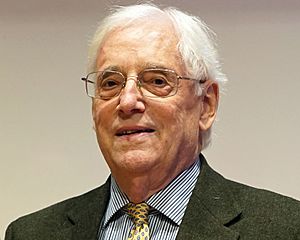John E. Walker facts for kids
Quick facts for kids
Sir John Walker
FRS FMedSci
|
|
|---|---|

Walker in 2018
|
|
| Born |
John Ernest Walker
7 January 1941 Halifax, West Riding of Yorkshire, England
|
| Education | Rastrick Grammar School |
| Alma mater | University of Oxford |
| Spouse(s) |
Christina Westcott
(m. 1963) |
| Children | Two |
| Awards |
|
| Scientific career | |
| Institutions | University of Oxford Laboratory of Molecular Biology University of Cambridge |
| Thesis | Studies on naturally occurring peptides (1970) |
| Doctoral advisor | Edward Abraham |
Sir John Ernest Walker, born on January 7, 1941, is a famous British chemist. He won the Nobel Prize in Chemistry in 1997 for his important discoveries. As of 2015, he was a top professor and director at the MRC Mitochondrial Biology Unit in Cambridge. He is also a Fellow at Sidney Sussex College, Cambridge.
Contents
Early Life and School
John Walker was born in Halifax, Yorkshire, England. His father, Thomas Ernest Walker, was a stonemason, and his mother, Elsie Lawton, loved music. John grew up in the countryside with his two younger sisters, Judith and Jen. He went to Rastrick Grammar School.
At school, John loved sports. In his last three years, he focused on science and math. He later studied chemistry at St Catherine's College, Oxford. In 1965, he started studying special tiny molecules called peptides with Edward Abraham at Oxford. He earned his PhD degree in 1969. During this time, he became very interested in molecular biology, which is the study of life at a very small, molecular level.
Amazing Discoveries
From 1969 to 1974, John Walker worked as a researcher in the United States and France. In 1974, he met a famous scientist named Fred Sanger at a workshop in Cambridge. This meeting led to an invitation for John to work at the MRC Laboratory of Molecular Biology. He ended up staying there for a long time!
At the lab, he worked with other brilliant scientists, including Francis Crick, who helped discover the structure of DNA. John first studied the order of parts in proteins. Then, he learned about the special genetic code inside mitochondria. Mitochondria are like the powerhouses of our cells.
In 1978, he started using chemical methods to study proteins found in cell membranes. He figured out what parts made up the proteins in the mitochondrial membrane. He also studied the DNA sequence of the mitochondrial genome.
How Cells Get Energy
John Walker's most important work was studying a protein called F1-ATPase. This protein is part of a bigger machine called ATP synthase. Think of ATP synthase as a tiny motor in our cells that makes energy. It creates a molecule called ATP, which is like fuel for our bodies.
Working with another scientist, Andrew Leslie, John used special techniques to look at the structure of F1-ATPase. They found that this protein has three active sites, which are like tiny factories. These sites change shape as they work, helping to make ATP. This discovery showed how the ATP synthase machine spins like a motor to create energy.
This amazing work was published in 1994. It helped John Walker win the Nobel Prize in Chemistry in 1997. Since then, John and his team have continued to study ATP synthase, creating many detailed pictures of its structure. Their work has helped other scientists understand how our cells get energy.
Awards and Special Honors
John Walker has received many awards for his scientific work.
- In 1984, he became an EMBO Member.
- In 1997, he shared the Nobel Prize in Chemistry with American chemist Paul D. Boyer. They won for explaining how ATP is made in cells. They also shared the prize with Danish chemist Jens C. Skou, who discovered a different important cell pump.
- In 1999, Queen Elizabeth II made him a knight, so he became Sir John Walker. This was for his great contributions to molecular biology.
- He is also a member of the Advisory Council for the Campaign for Science and Engineering.
- In 1995, he became a Fellow of the Royal Society (FRS), which is a very high honor for scientists in the UK.
- He is an Honorary Fellow of St Catherine's College, Oxford, and a foreign member of the National Academy of Sciences in the USA.
- In 1999, he became a foreign member of the Royal Netherlands Academy of Arts and Sciences.
- In 2012, he received the Copley Medal, another very important science award.
Personal Life
John Walker married Christina Westcott in 1963. They have two daughters.
See also
 In Spanish: John E. Walker para niños
In Spanish: John E. Walker para niños

